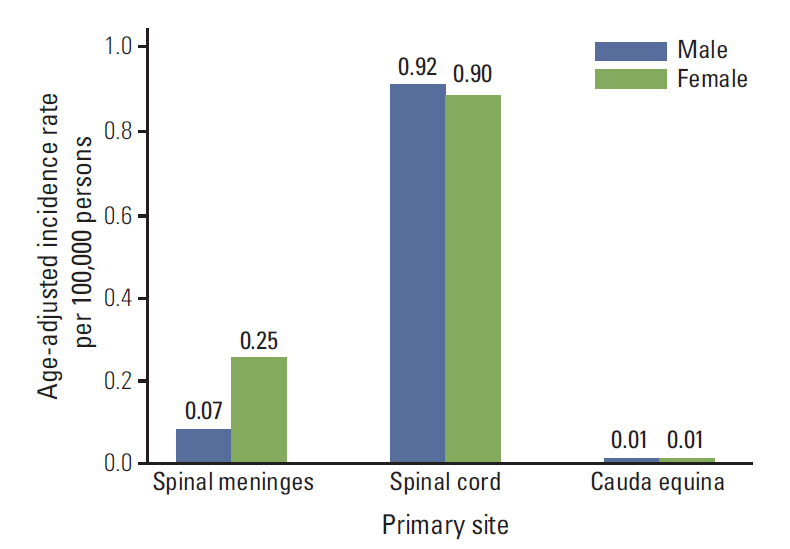Cancer Res Treat.
2015 Apr;47(2):166-172. 10.4143/crt.2014.017.
Incidence of Primary Spinal Cord, Spinal Meninges, and Cauda Equina Tumors in Korea, 2006-2010
- Affiliations
-
- 1The Korea Central Cancer Registry, National Cancer Center, Goyang, Korea. astra67@ncc.re.kr
- 2Neuro-Oncology Clinic, National Cancer Center, Goyang, Korea. heonyoo@ncc.re.kr
- KMID: 2132794
- DOI: http://doi.org/10.4143/crt.2014.017
Abstract
- PURPOSE
Primary spinal cord and appendage tumors (PSCAT) originating from the spinal cord, spinal meninges, and cauda equina are uncommon. Worldwide, population-based cancer registry data are mostly based on malignant tumors only, which means few data are available on PSCATs, including non-malignant tumors. Therefore, the objective of this study was to provide information regarding the incidence of both non-malignant and malignant PSCATs in Korea on a national level.
MATERIALS AND METHODS
Incidence of PSCATs was estimated from cases diagnosed between 2006 and 2010 using the National Cancer Incidence Database in Korea. Age-adjusted rates were calculated using the world standard population, and male-to-female rate ratios were calculated by histology type.
RESULTS
Of all PSCATs registered (n=3,312), 86.6% were non-malignant. The overall age-adjusted incidence of PSCATs was 1.08 per 100,000 person-years, with an incidence of 0.99 per 100,000 in females and 1.15 in males. The most common site of PSCATs was the spinal cord (83.4%), followed by spinal meninges (16.1%) and cauda equina (0.5%). The most common histological type was neurilemmoma (41.3%), followed by meningiomas (20.1%) and ependymomas (7.6%). Men had significantly higher rates than women for ependymomas and lymphomas but had lower rates for meningiomas.
CONCLUSION
This study provides the first population-based analysis of PSCATs in Korea.
Keyword
MeSH Terms
Figure
Cited by 1 articles
-
A Nation-Wide Epidemiological Study of Newly Diagnosed Primary Spine Tumor in the Adult Korean Population, 2009–2011
Seil Sohn, Jinhee Kim, Chun Kee Chung, Na Rae Lee, Moon Jun Sohn, Sung Hwan Kim
J Korean Neurosurg Soc. 2017;60(2):195-204. doi: 10.3340/jkns.2016.0505.011.
Reference
-
References
1. Engelhard HH, Villano JL, Porter KR, Stewart AK, Barua M, Barker FG, et al. Clinical presentation, histology, and treatment in 430 patients with primary tumors of the spinal cord, spinal meninges, or cauda equina. J Neurosurg Spine. 2010; 13:67–77.2. Elia-pasquet S, Provost D, Jaffre A, Loiseau H, Vital A, Kantor G, Et Al. Incidence Of Central Nervous System Tumors In Gironde, France. Neuroepidemiology. 2004; 23:110–7.3. Liigant A, Asser T, Kulla A, Kaasik AE. Epidemiology of primary central nervous system tumors in Estonia. Neuroepidemiology. 2000; 19:300–11.4. Schellinger KA, Propp JM, Villano JL, McCarthy BJ. Descriptive epidemiology of primary spinal cord tumors. J Neurooncol. 2008; 87:173–9.5. Duong LM, McCarthy BJ, McLendon RE, Dolecek TA, Kruchko C, Douglas LL, et al. Descriptive epidemiology of malignant and nonmalignant primary spinal cord, spinal meninges, and cauda equina tumors, United States, 2004-2007. Cancer. 2012; 118:4220–7.6. Central Brain Tumor Registry of the United States. CBTRUS statistical report: primary brain and central nervous system tumors diagnosed in the United States in 2004-2007. Hinsdale: Central Brain Tumor Registry of the United States;2011.7. Davis FG, Freels S, Grutsch J, Barlas S, Brem S. Survival rates in patients with primary malignant brain tumors stratified by patient age and tumor histological type: an analysis based on Surveillance, Epidemiology, and End Results (SEER) data, 1973-1991. J Neurosurg. 1998; 88:1–10.8. Surawicz TS, McCarthy BJ, Kupelian V, Jukich PJ, Bruner JM, Davis FG. Descriptive epidemiology of primary brain and CNS tumors: results from the Central Brain Tumor Registry of the United States, 1990-1994. Neuro Oncol. 1999; 1:14–25.9. Johannesen TB, Angell-Andersen E, Tretli S, Langmark F, Lote K. Trends in incidence of brain and central nervous system tumors in Norway, 1970-1999. Neuroepidemiology. 2004; 23:101–9.10. Materljan E, Materljan B, Sepcic J, Tuskan-Mohar L, Zamolo G, Erman-Baldini I. Epidemiology of central nervous system tumors in Labin area, Croatia, 1974-2001. Croat Med J. 2004; 45:206–12.11. Shin HR, Won YJ, Jung KW, Kong HJ, Yim SH, Lee JK, et al. Nationwide cancer incidence in Korea, 1999~2001; first result using the national cancer incidence database. Cancer Res Treat. 2005; 37:325–31.12. Lee CH, Jung KW, Yoo H, Park S, Lee SH. Epidemiology of primary brain and central nervous system tumors in Korea. J Korean Neurosurg Soc. 2010; 48:145–52.13. Curado MP, Edwards B, Shin HR, Storm H, Ferlay J, Heanue M, et al. Cancer incidence in five continents. Lyon: International Agency for Research on Cancer;2008.14. Jung KW, Park S, Kong HJ, Won YJ, Lee JY, Park EC, et al. Cancer statistics in Korea: incidence, mortality, survival, and prevalence in 2008. Cancer Res Treat. 2011; 43:1–11.15. Fritz A, Percy C, Jack A, Shanmugaratnam K, Sobin L, Parkin DM, et al. International classification of diseases for oncology. 3rd ed. Geneva: World Health Organization;2000.16. Segi M. Cancer mortality for selected sites in 24 countries (1950-1957). Sendai: Department of Public Health, Tohoku University School of Medicine;1960.
- Full Text Links
- Actions
-
Cited
- CITED
-
- Close
- Share
- Similar articles
-
- Bisected Vertebral Body Fracture Trapping Cauda Equina: A Case Report
- A Case of Giant Ependymomas of the Cauda Equina associated with Thoracic Intradural Spinal A-V Malformations
- A Case of Dermoid in the Thoracolumbar Region
- Clinical Study of Spinal Cord Tumor and Metastasis Causing Cord Compression
- Cauda Equina Syndrome after Spinal Manipulative Therapy: A case report


